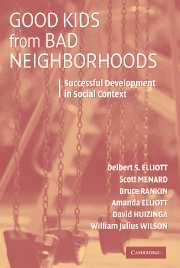Book contents
- Frontmatter
- Contents
- List of Tables and Figures
- Foreword by Richard Jessor
- Acknowledgments
- 1 Growing Up in Disadvantaged Neighborhoods
- 2 Growing Up in Denver and Chicago: The MacArthur Neighborhood Study
- 3 Good and Bad Neighborhoods for Raising Children
- 4 The Effects of Growing Up in a Bad Neighborhood: Initial Findings
- 5 Critical Dimensions of Neighborhood Organization and Culture
- 6 The Effects of Neighborhood Organization and Culture
- 7 Family Influences: Managing Disadvantage and Promoting Success
- 8 School Climate and Types of Peer Groups
- 9 What Matters Most for Successful Youth Development?
- 10 Successful Development in Disadvantaged Neighborhoods
- Appendix A
- Appendix B
- References
- Author Index
- Subject Index
5 - Critical Dimensions of Neighborhood Organization and Culture
Published online by Cambridge University Press: 06 August 2009
- Frontmatter
- Contents
- List of Tables and Figures
- Foreword by Richard Jessor
- Acknowledgments
- 1 Growing Up in Disadvantaged Neighborhoods
- 2 Growing Up in Denver and Chicago: The MacArthur Neighborhood Study
- 3 Good and Bad Neighborhoods for Raising Children
- 4 The Effects of Growing Up in a Bad Neighborhood: Initial Findings
- 5 Critical Dimensions of Neighborhood Organization and Culture
- 6 The Effects of Neighborhood Organization and Culture
- 7 Family Influences: Managing Disadvantage and Promoting Success
- 8 School Climate and Types of Peer Groups
- 9 What Matters Most for Successful Youth Development?
- 10 Successful Development in Disadvantaged Neighborhoods
- Appendix A
- Appendix B
- References
- Author Index
- Subject Index
Summary
SYNOPSIS
Our central concern in this study of neighborhoods, is how youth living in bad neighborhoods can avoid or overcome the negative influences of this set of compositional and physical conditions and grow up to be healthy, well-functioning, productive adults. At the neighborhood level, the type of social organization and culture that emerges from the social interaction in the neighborhood provides a set of conditions that can either neutralize these ecological influences or aggravate them; can support and encourage a positive course of development or compound the negative influences of disadvantage and deterioration on youth development. These organizational structures include both formal and informal organizations. In good neighborhoods, the formal institutions that serve the neighborhood, such as schools, city recreational programs, local employers, businesses, and police, have a strong, visible presence and provide effective services to the neighborhood. Neighbors create a set of interconnected informal networks of adults and children that directly promote positive developmental outcomes, provide controls on dysfunctional behavior, and provide a “safety net” for families experiencing difficulties in raising their children. As neighbors interact, they also develop shared understandings about appropriate goals, attitudes and behavior for their children, creating a normative climate or culture, which sets boundaries on acceptable behaviors and expectations for achievement and particular lifestyles. Finally, in a good neighborhood, the organizational structures and common culture enable the neighborhood to effectively resist the intrusion of any organized criminal activity or other threats to the stability and order in the neighborhood.
- Type
- Chapter
- Information
- Good Kids from Bad NeighborhoodsSuccessful Development in Social Context, pp. 101 - 128Publisher: Cambridge University PressPrint publication year: 2006



